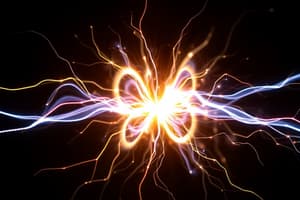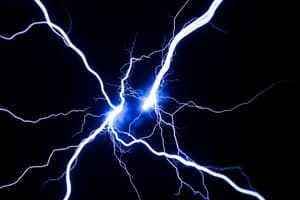Podcast
Questions and Answers
Which of the following best describes the term 'net charge'?
Which of the following best describes the term 'net charge'?
- The charge of one electron.
- The charge of one proton.
- The difference between proton and electron charge.
- The sum of all positive and negative charges in an object. (correct)
What principle states that if a system starts with equal charge distributions, it will remain in equilibrium unless a charge is added or removed?
What principle states that if a system starts with equal charge distributions, it will remain in equilibrium unless a charge is added or removed?
- Coulomb's Law.
- Gauss' Law.
- Ohm's Law.
- Law of Conservation of Charge. (correct)
According to Coulomb's Law, how does the force between two charges change if the distance between them is doubled?
According to Coulomb's Law, how does the force between two charges change if the distance between them is doubled?
- It is reduced to one-half.
- It doubles.
- It quadruples.
- It is reduced to one-quarter. (correct)
What is the relationship described by Gauss' Law?
What is the relationship described by Gauss' Law?
What is a Gaussian surface?
What is a Gaussian surface?
Electric potential is also known as:
Electric potential is also known as:
What is the term for an electric component that stores electrical energy within an electric field?
What is the term for an electric component that stores electrical energy within an electric field?
What is a 'dielectric' in the context of capacitors?
What is a 'dielectric' in the context of capacitors?
In a series circuit, what quantity is the same through all components?
In a series circuit, what quantity is the same through all components?
In a parallel circuit, what quantity is the same across all components?
In a parallel circuit, what quantity is the same across all components?
What does a fuse do in an electrical circuit?
What does a fuse do in an electrical circuit?
Which device is designed to detect tiny mismatches in currents to prevent electrocution, and is often required in bathrooms and kitchens?
Which device is designed to detect tiny mismatches in currents to prevent electrocution, and is often required in bathrooms and kitchens?
What is the function of the third prong on a three-pronged plug?
What is the function of the third prong on a three-pronged plug?
What is 'conductance'?
What is 'conductance'?
According to Ohm's Law, what is the relationship between current, voltage, and resistance?
According to Ohm's Law, what is the relationship between current, voltage, and resistance?
What is the difference between an ohmic and a non-ohmic device?
What is the difference between an ohmic and a non-ohmic device?
What is 'electromotive force'?
What is 'electromotive force'?
What is a Lichtenberg figure?
What is a Lichtenberg figure?
What is the current law?
What is the current law?
What components are present in an RC circuit?
What components are present in an RC circuit?
Flashcards
Charge
Charge
Fundamental physical quantity responsible for electrical phenomena, measured in Coulombs (C).
Net Charge
Net Charge
The sum of all positive and negative charges present in an object.
Triboelectric Series
Triboelectric Series
A list ranking materials by their ability to gain or lose electrons upon friction.
Law of Conservation of Charge
Law of Conservation of Charge
Signup and view all the flashcards
Coulomb's Law
Coulomb's Law
Signup and view all the flashcards
Electric Field
Electric Field
Signup and view all the flashcards
Gauss' Law
Gauss' Law
Signup and view all the flashcards
Gaussian Surface
Gaussian Surface
Signup and view all the flashcards
Electric Flux
Electric Flux
Signup and view all the flashcards
Equipotential Surface
Equipotential Surface
Signup and view all the flashcards
Electric Potential
Electric Potential
Signup and view all the flashcards
Potential Difference
Potential Difference
Signup and view all the flashcards
Work (electric)
Work (electric)
Signup and view all the flashcards
Capacitor
Capacitor
Signup and view all the flashcards
Capacitance
Capacitance
Signup and view all the flashcards
Dielectric
Dielectric
Signup and view all the flashcards
Series Circuit
Series Circuit
Signup and view all the flashcards
Parallel Circuit
Parallel Circuit
Signup and view all the flashcards
Resistance
Resistance
Signup and view all the flashcards
Ohm's Law
Ohm's Law
Signup and view all the flashcards
Study Notes
- Study notes for General Physics 2
- These notes are for the 3rd Quarter Review
Charge
- Charge is a fundamental physical quantity responsible for electrical phenomena
- The unit for charge is the Coulomb (C)
- Net charge is the sum of all positive and negative charges in an object
- Triboelectric series shows a list of materials that shows their capability to hold electrons upon gaining them, and their capacity to lose electron when subjected to friction
- The law of conservation of charge states if a system starts with equal charge distributions, the system will be in a state of equilibrium, unless a charge is added or removed from the system
- This law was developed by Benjamin Franklin
- Coulomb's Law: product of two (2) charge values multiplied to a proportionality constant, and divided by the square of the distance between the charges
- An electric field exists in a region around a charged particle
- It is a region associated to each point in space where the Coulomb force will be experienced
- Gauss' Law relates the electric field at all points on a closed surface and the total charge enclosed within the surface
- A Gaussian surface is a hypothetical surface immersed in an electric field that may or may not enclose a charge
- Electric flux is the strength of an electric field over an area in a field region
- A proton refers to a particle with an outward force
- An electron refers to a particle with an inward force
- A neutron has a charge equal to 0
- Equipotential surface describes a region in space where points in the electric field have equal potential, represented by lines surrounding the point charge
- Electric potential energy is potential energy due to a moving charge changing displacement within a projected electric field provided by a rest charge
- Electric potential, also known as voltage, is electric potential energy per unit charge, which arose due to the location of a charge within the electric field
- Potential difference is the difference between two electric potential values, which is responsible for the generation of electric current
- Earth's potential is equal to 0
- Work is the influence of a rest charge over a moving charge moving within the rest charge's electric field
- Potential gradient is the local rate of change of a potential with respect to the displacement
- A capacitor, also known as a condenser, is an electric component that stores electrical energy within an electric field
- Capacitance refers to the ability of a capacitor to store charge, which will change the voltage of a body by one
- Stored energy is energy stored due to half the work performed
- Electric field energy refers to the energy of the electric field, which is equal to the electric field's energy density
- A dielectric is an insulating material inserted between a capacitor's parallel plates, which increases capacitance without compromising the capacitor's separation distance
- Equivalent capacitance is the total capacitance within sets of given capacitors
- Series circuit refers to connected devices in the system is in a single fashion, sharing charge values
- Parallel circuit refers to connected devices in the system is independent from each other, sharing voltage values
- A gaussian surface doesn’t enclose a charge, value of a charge is equal to 0
- Electric work is defined as the loss of potential energy in a test charge moving in an electric field
- Michael Faraday: the unit farad is named after him
- The Philippine Electrical Code (RA7920) provides an act for practice, licensure, and regulation of electrical engineers and electricians
Electricity and Circuits
- A shuttered socket is a device fitted with internal protective shutters to protect children from electrocution
- Fuses protect circuits from excessive current by melting if the current is high enough, opening the circuit, and stopping the current flow
- Circuit breakers protect circuits from current overload, functions similarly to fuses, but do not get destroyed, making this a long-term safety device
- Ground fault circuit interrupters are designed to detect a tiny mismatch in currents to prevent electrocution and are mandatory in bathrooms, kitchens, or anywhere else in the house where water may come in contact with an electric circuit
- An equipotential earth point/stud is a device installed alongside plug sockets to the equipotential earthing system, which ensures all equipment is grounded at the same low potential
- Three-pronged plugs are plugs with a round prong that serves as the ground outlet for the device, which connects to the ground wire of the building
- Electrolysis occurs when polarized ions causes ulceration on the affected area
- Burns are due to low-to-high powered voltages that can cause minor to serious injuries
- Muscle cramps are uncontrollable muscular twitching due to electrical over stimulation
- Ventricular fibrillation is the same as muscle cramps, but affects the heart
- Electric current is the amount of charge in a conductor per unit time
- Direct current has both constant voltage and direction and is primarily used in battery-operated devices
- Alternating current means current direction and magnitude changes in between two extreme values, periodically reverses direction, and used in daily living
- Conventional alternating current means current flows from positive terminal of the source towards the negative
- Electron current flows from the negative terminal of the source towards the positive
- Current density is the amount of current per unit of area
- Drift velocity is the net motion of charged particles in groups
- Resistance is the property of a material to resist current, measured in Ohms (Ω)
- Conductance is the inverse of resistance, which is the property of the material to conduct electric current, measured in siemens (S)
- Resistivity is a measure of a material’s electrical resistance
- Conductivity is the inverse of resistivity, which is the measure of a material’s conductance
- Ohm’s Law was developed by Georg Simon Ohm which states that current is proportional to voltage, and inversed with resistance
- A curve is a graph that shows the relationship between current and resistance
- An ohmic device is a device that demonstrates Ohm’s law, with constant resistance
- A non-ohmic device is a device that does not show Ohm’s law
- Power is the rate at which energy is transferred
- Electromotive force is the work done by the voltage source to the circuit, always constant; the “cause” of a voltage’s occurrence
- Internal resistance is the resistance of a power source
- Terminal potential difference is the output voltage of a source, when internal resistance is considered
- Electrical hazard is a condition concerning man and electrical equipment, which results to injuries and/or death
- Electric shock is the physiological injury caused by passing electric current
- A lichtenberg figure shows a tree-like pattern
- Electrocution is death due to electric shock
- Current Law: At any junction in an electrical circuit, the sum of currentsflowing into the junction is equal to the sum of the currents flowing out
- Voltage Law: The sum of voltages encountered in a complete traversal of anyloop of a circuit (or mesh) is zero
- An RC circuit is a circuit with a resistor and a capacitor, which filters signals
Magnetism
- A magnet is a material capable of interacting with other materials easily influenced by magnetism
- A magnetic pole is a region of a magnet that is polarized
- A magnetic field is a field of force surrounding a magnet
- Lorentz force is the force influenced by both electric and magnetic forces
- Cyclotron radius is the radius of charged particles circular motion
- Cyclotron frequency is the angular frequency of a charged particle’s circular motion
- Magnetic flux is a measure of a magnetic field strength per area, measured in Weber
- A solenoid is a conducting wire coiled in a helix, which functions similarly as arranged single-loop conductors
- Biot-Savart Law describes the magnetic field being generated by changing electric fields, being consistent with both Ampere’s and Gauss’s Laws
- Ampere’s Law relates current and magnetic field
- Electric force refers to when it is projected parallel from the electric field
- Magnetic force refers to when it is projected perpendicular from the magnetic and electric fields
- Current density is a particle which is not part of drift velocity
Studying That Suits You
Use AI to generate personalized quizzes and flashcards to suit your learning preferences.




